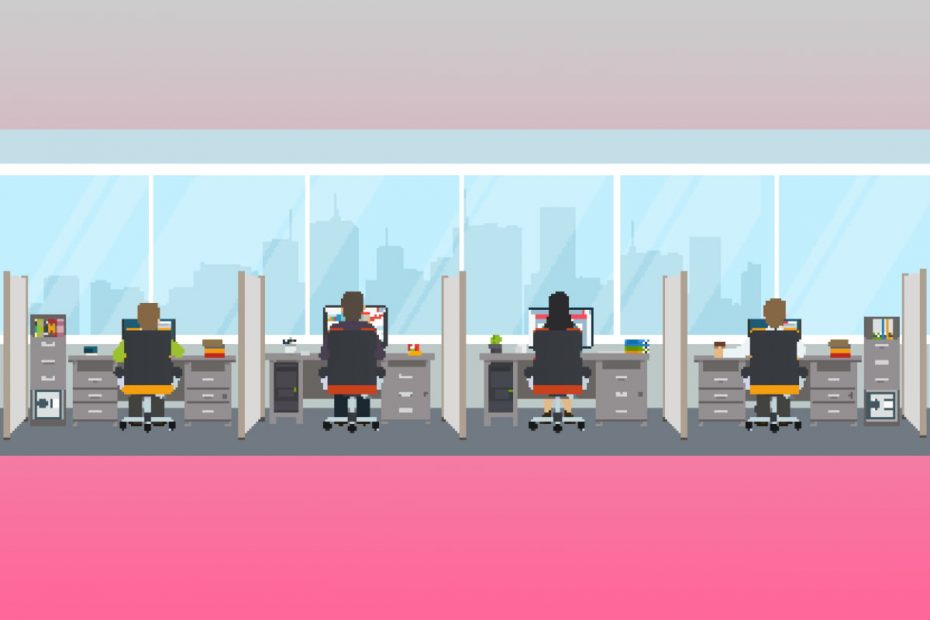Home versus office working
In the UK we’ve just experienced a dramatic switch to home working – from 12% working from home before the Pandemic, to over 40% now. There are plenty of commentators telling us that everything has changed and that working from home, where it is possible, is the next ‘normal’. You might have seen this recent article in The Guardian, The office is obsolete. And that’s a good thing.
But will this really be true? Talentsmoothie research suggests otherwise.
It is, of course, unlikely that companies will return to exactly what they did before C-19. There is an opportunity to learn from the massive work-from-home experiment that so many of us have been living. Every organisation should reflect on their experience and what has been learned, both positive and negative. It’s most likely that what comes next will be some kind of hybrid with the way we worked pre-Covid.
Any organisations previously nervous to allow working from home – because of technology security concerns, productivity concerns, or just not being comfortable with the concept – have had the opportunity to see that it can have real benefits. Myths have been quashed, and leaders may be more open to it as a more frequent way of working as a result.
So, what do employees want?
First, we need to understand how working from home was for everyone and what the best solution moving forward could be. Here are some of our learnings from employees we’ve surveyed, HR Directors we’ve spoken to and our own generational research.
The case for more home working
1. Productivity: Working from home doesn’t appear to negatively impact productivity – people felt that they could be really focused and productive, and that they were trusted to get their work done. Yes, the situation right now, where people are juggling work with other caring responsibilities, is not particularly easy, but under more normal circumstances the majority of people, we spoke to, felt working from home did not hamper their ability to get the job done and, in many cases, improved it.
2. Inclusion: For some, the use of technology (audio or video) for meetings was a real positive. Where they might not have felt confident to speak up in a face-to-face meeting, an online meeting felt more inclusive and empowering and easier to contribute to. It’s actually harder to talk over people online, making it easier for introverts to take part. Building on this, observational research at the Smith School of Business at Queen’s University, Ontario suggests introverts do their best work without threat of interruption, and so remote working can aid their productivity as well as their wellbeing. (Extroverts on the other hand are more likely to suffer, as one of their assets is their ability to communicate with people face-to-face.)
3. Connection: Having video on and thus seeing people in their own homes has really connected people. They’ve seen another side of their colleagues, which has brought them together, and that’s been a positive. It seems to have a levelling affect. We feel we are connecting with another human being, rather that someone in a position or a role.
4. Networks: Online working has encouraged people to reach out to more people within and outside of their organisation and to make new connections. This is totally natural for the younger generations but perhaps less so for the Xers and Boomers. It encourages and supports a shift, from the traditional hierarchical structures we see in many organisations today towards a more networked structure, which we know is a preference of Gen Ys (born between 1980 and 1994) and Gen Zs (born 1995 onwards). Understanding your company’s natural network and how things get done will further support a change in how organisations structure themselves; it will help to inform the right balance between office space and homeworking in the future.
5. Wellbeing: From a wellbeing perspective, some employees find it easier to switch off when they work from home and they set themselves better rules; when in the office it’s easier to work late. There’s also the saved time on the commute – although there are some who find the commute a great opportunity to decompress before arriving home! Reduced travel might also contribute to the ‘wellbeing’ of the environment, of course.
These five points give some compelling reasons to reduce time in the office and continue to trust employees to work from home.
However, it seems that ‘the office’ is definitely not dead.
The case for maintaining at least some office space
There are some good reasons to maintain office space going forward, even if you decide to reduce the amount you have. Employees told us:
- How important incidental conversations with colleagues are for their sanity, either for idea generation or just to have a chat about things beyond a work focus. These are harder to replicate online. All our research tells us that face-to-face is still the preferred method of communication for all generations, and that includes Gen Z.
- Working in the office helps with setting boundaries between work and home, which, for some, can be hard to achieve when working from home.
- The routine and discipline of going to the office can be important too for mental health.
- Others were just struggling with the space they have at home – it isn’t conducive to working productively, for them, either because they literally don’t have enough room, or they don’t have the right equipment to create a comfortable working environment.
As well as this, our Generational research over the last twelve years has shown that the preference for where people work is a mix between home and the office, with a slight preference for more time in the office than at home.
In our recent Gen Z survey, (the results of which we are yet to publish) on the topic of preferred mix of work location, 40% of respondents said their preference would be to work 30% from home and 70% in the office. Only 4% said they would like to work 100% at home, and 14% said they’d like to be 100% in the office.
This follows a similar pattern to that from our Gen Y research in 2008 where the most popular response (37%) was for 30% home and 70% office. Our Baby Boomer research (seven years ago) showed the same preference for 30% home 70% office work mix. It’s possible the Covid experience could have pushed this preference more towards home working but it’s clear a blended mix is important. The exact mix will differ from one individual to the next.
How to transition as smoothly as possible
Whatever the right blend turns out to be for your business, we leave you with our talentsmoothie tips to help you make a successful transition to the next work normal:
- Don’t rush to go straight back to what you did before – look at what your business and employees need, and decide on the best combination of home/office-working. From our research, we’d suggest this should be somewhere around 30% home, 70% office, or even 50/50. Most people aren’t ready to switch to 100% home working yet.
- Keep employee motivation high during this transition period. Now is your opportunity to remove any culture of presenteeism. Embrace the technology and trust and empower people to get the job done. Being trusted at work always features highly during any employee research we conduct, and it continues to be important for the new generation entering the work place now. In our most recent survey, Gen Zs said that the most essential pre-requisite for a good manager was ‘being trusted to do the job’; they put it above things like ‘supporting my wellbeing’ and ‘being supported to develop my career’, although these were also important.
- Continue to encourage and coach managers to manage the outcome and not the process, as this fosters the culture of trust, empowerment and accountability that we know works for so many people.
- Move from a one size fits all, to adopt a more individualistic approach where possible, showing an understanding of personal circumstance and requirements. Talent will have the opportunity to work flexibly somewhere – if you don’t offer it, other organisations will.
- Get the mix right, so that you can maximise face-to-face premium time (particularly important for extroverts) as well as give the opportunity to work from home (great for introverts) where there are less distractions. But, make sure working from home does not mean back-to-back Zoom calls – to offer space that allows teams to be as productive as possible is the way forward.
- Consider using technology to understand your natural networks i.e. who is networking with whom to get things done. This information will help inform how the organisation should be structured, to optimise ways of working that will deliver business success and create the best Employee Experience.
How talentsmoothie can help
We’d like to share our knowledge and expertise during this period. Please check back for our blog posts and for our new podcast series What about this? going live mid June. ( UPDATE 17th June 2020, our first podcast is now available, do take a look: What about this? Podcast series, Episode 1: Office v homeworking – the optimal mix? )
We don’t have all the answers, but, by contributing what we know, we hope we can help you make good decisions for your organisation and your people over the months ahead. Our focus is on helping organisations understand what’s important to their employees and how that might have changed. We’re reviewing Employee Value Propositions to make sure they will create the culture required for success in the ‘next normal’. We’re also supporting individuals with coaching and, in some cases, outplacement support, and we’ve reduced our prices in order to help as many people as we can. Please talk to us about how we could help you.
Or, download our printable PDF flyer containing details of some of our C-19 offerings.
Visit our Insights page for free-to-download Factsheets on Employee Value Proposition EVP, Employee Engagement and lots of other free resources including our research reports.

